![]()
The Words of the Gehring Family
|
|
The Words of the Gehring Family |
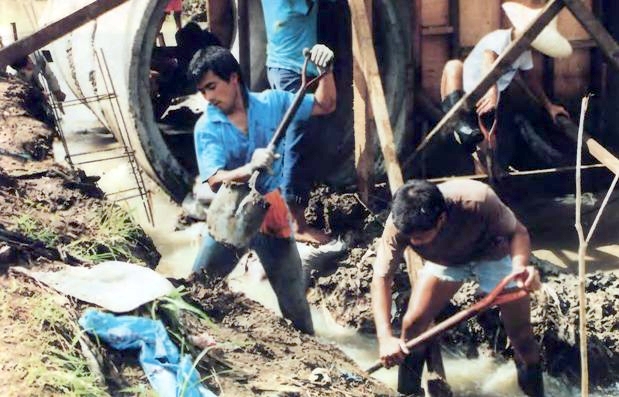
On July 10, one hundred ten young people from 34 countries gathered in Manila to take part in the first historic project of the Religious Youth Service (RYS). The aim of RYS, which grew out of an appeal by Father at the 1985 Assembly of the World's Religions, is to actively create inter-religious harmony through dialogue and cooperative service to third world countries. In just three weeks these energetic volunteers from a dozen different faiths, working in the squalor of some of the most poverty-stricken areas of the Philippines, put their universal religious principles into action by digging septic tanks and wells, building an elementary school and a concrete bridge, and planting 8,000 mahogany trees.
Originally, this first RYS project, jointly sponsored by the International Religious Foundation (IRF) and the International Relief Friendship Foundation (IRFF), was scheduled to take place in Senegal, but because of unforeseen circumstances, it was relocated to the Philippines in May.
The participants, coming from such diverse traditions as Buddhism, Islam, Judaism, Hinduism, Jainism, Sikhism, Christianity, Unificationism, Confucianism, Taoism, and others, were warmly welcomed on their first day by Cardinal Sin, the head of the Catholic Church in the Philippines, at his residence. He offered words of blessing and encouragement, stressing that RYS could help bind the religious communities of the Philippines together. Rev. Kwak addressed the Cardinal, describing the purpose and vision of RYS, and Ron Jordan, representing all the participants, thanked the Cardinal for his enthusiastic support.
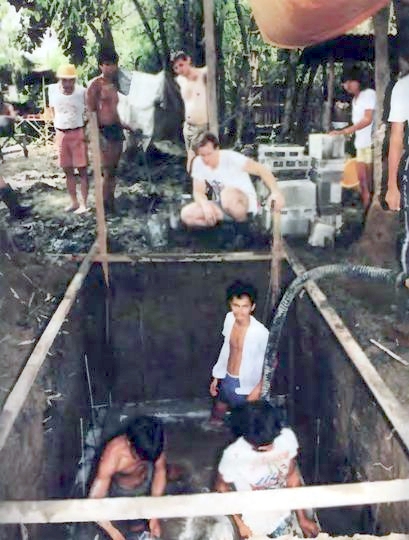
The group was then warmly received at the Presidential Palace by President Corazon Aquino -- a woman of great dignity, warmth, and faith in God. "Prayer power is behind people power," she told them. "We do appreciate your concern for our country, because this is what it is all about -- helping one another" When the audience had finished applauding her speech, she walked right into their midst; everyone gathered around to shake her hand and offer heartfelt thanks and best wishes.
On the second day, guest professors from the community presented lectures on Philippine culture, customs, and history at the Maryhill Catholic Retreat Center, and Rev. Kwak spoke on "The Responsibility of Youth in Our Global Village:' Everyone also had a chance to visit a Taoist temple, a local mosque, a Catholic cathedral, and a Buddhist temple, and to take part in the ceremonies there.
The next day the group divided into three teams and departed for the work sites. The religious principles and youthful idealism of the participants were destined to meet the difficult challenges of real life in an impoverished nation.
One of the sites, Apalit, a township in Pampanga, is a barrio, recently hard hit by typhoon-related flooding. Extended families live in cardboard and cinder block houses with little or no fresh water or plumbing. Unsanitary conditions, malnutrition, and infectious diseases are rampant as a result of poverty. Under the leadership of Dr. George Emery and the planning of Simon Herbert, the volunteers dug deep holes for septic tanks and constructed 35 toilet facilities. To provide clean, potable water, they dug 10 artesian wells, 120 feet deep, complete with hydraulic water pumps.
The work was extremely dirty and messy. Relates Michael Giampaoli, RYS project coordinator:
The participants were in a situation where they had to sacrifice and serve. We put them in a very poor environment. The food was not good; they weren't staying in 5-star hotels. And they had to really sweat and work hard, with the mosquitos, with the flies, and with the smells of the area, which were not pleasant. That experience opened them up to receive God's love. And they were changed, they were visibly changed.
Brenda Svensen, one of the Unificationist volunteers, gives this testimony:
The Filipinos were very curious about us. We were a group of such international people, with very bright spirits, ready to work. First of all they saw that women were working with a shovel. In the Philippines that just isn't done. We spoke different languages. There were Sikhs wearing their turbans, and there were Oriental girls working just as hat d as the men. Actually we were treated like VIPs. The schoolchildren gathered around us, wanting our autographs, wanting our address, and we had like a passionate love affair with the people.
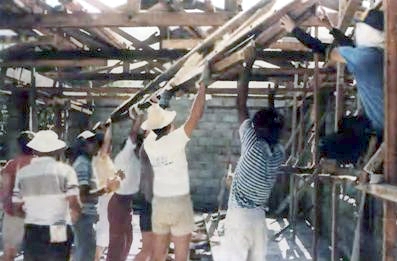
One little six-year-old girl came to help push back the mud. Every evening she would take everyone's work gloves home, wash them, and have them ready the next day when they arrived. She always sang and played joyfully with them. All of a sudden one day she wasn't there. One of the volunteers went to ask her parents about her, only to find out that she had died from cholera the night before. The volunteers were agonized to learn of her untimely death. Cholera is not common, but unsanitary conditions compounded by malnutrition had left the child exposed and without resistance. The stark reality of poverty hit home, and the value of the work the volunteers were doing took on a new and much more urgent meaning.
Brenda Svensen adds:
The Filipinos are very open heartistically, and very giving, even though they don't have anything. They gave more than they had in gratitude for what we did. It was just septic tanks, but it was life and death for them. We felt our presence there went way, way beyond the difficult things we did, but more it was like an injection of hope.
Michael Giampaoli:
When the volunteers left the work site it was a very tearful kind of experience. The Filipino people would just cry tears, coming with their children and their parents and embracing our participants. They never had this kind of experience before where someone would just embrace them, crying, "Don't leave! You can't go! You must stay!" One participant said afterward, "If I die tomorrow, my life is fulfilled, because I worked on this project."
At Iloilo Island, the second work site, the RYS team was overwhelmed by a reception given by the students and faculty of the West Visayas State College of Science and Technology (WCVST). Four thousand students greeted them with cheers and a marching band. The college president Dr. Alfonso Albazon, the governor of the province, and the local mayor all addressed the volunteers, and native dancers performed traditional Filipino dances.
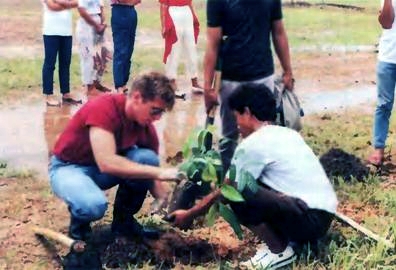
In the city of Iloilo the volunteers erected an elementary school for use by local children and student teachers. They were led by David Alexander, coordinated by Steve Kearny, and assisted by the college students.
Michael Giampaoli speaks about the school:
When we finished the building it was faced with very smooth cement, and it had glass windows. At the ending ceremony it was blessed by the local bishop with holy water. And everyone offered a prayer -- the Catholic bishop, the president of the university, and our member who was leading the project. And they put a plaque on the outside of the building: "Donated by the International Religious Foundation and the Religious Youth Service' The president of the university, who is responsible for the school, said that every year he will give a talk to all the school children about how their lives should be dedicated to world peace and religious harmony because of this building.
On nearby Guimaras Island, just a half-hour away by boat, another group of volunteers planted over 8,000 mahogany trees. The purpose of this project was to prevent soil erosion and eventually to bring in a cash crop to finance WCVST. In a special opening ceremony, the first seedlings were put in the ground by the governor and Rev. David Hose, RYS project director. With help from the students and national guard trainees, the planting was completed by the end of the second week, and during the third week volunteers aided construction work on the college campus.
The third project site was the resettlement area of Bagong Bayan in Dasmarinas, Cavite. Over 100,000 squatters were forced to move there from Manila about seven years ago. Literally refugees in their own country, they are unemployed and in serious need. The area has Christian and Muslim sections separated by a stream. During the rainy season (May to November), it is impossible for the children from the Muslim side to get to the school, which is on the Christian side.
At the suggestion of local Catholic Bishop Felix Perez, with the support of the Muslim community, and under the guidance of Dr. Ibraham Abu-Rabi and Jim Garland, a single-lane concrete bridge was built to connect the two communities. Volunteers from both the Christian and Muslim communities, engineering students from the Technical University of the Philippines, and the RYS team worked in cooperation under incredible pressure to complete the bridge construction in a mere three weeks. Under a burning sun, they dug through endless mud and sludge, and mixed and poured cement by hand throughout the day. Michael Giampaoli on one aspect of the bridge building:
The cement is mixed with lime. And you know what happens when lime gets on your hands. The skin of your hand starts to fall off. And then if you cut your hand on these broken- down buckets, the lime goes in your cut. And it's very, very painful -- extremely painful. Many of the participants the first week didn't have gloves. Everyone had about 25 bandages on their fingers. But it gave us an experience of what it must have been like -- a tiny experience of what it must have been like -- for Father to have to lift up those heavy bags of lime fertilizer.
The completed bridge, as it now stands serving the two communities, truly symbolizes the cooperative spirit of RYS. The sight of the Catholic bishop and the Islamic imam standing together on the bridge was a testimony to the inter-religious and international ideals that had become a reality.
At each site the work was grueling. The environment was so hot and smelly that sometimes it was hard just to get up in the morning. The volunteers challenged themselves to give their love continuously through hard work and sacrifice. The Filipino people returned their love by responding with gratitude and a real willingness to help -- even though they were greatly inconvenienced at times as the work progressed right in the midst of their living quarters. It was their encouragement that enabled the RYS volunteers to persevere to the end!
In fact, the response of the Filipino people was the central factor in helping the volunteers realize true international understanding and hope for world peace. Most of them testified that they received more from the Filipino people than they had given. Love was the real result of mutual service and sacrifice.
Most of the volunteers came from developed countries, or were quite well-to-do graduate students and professors from Third World nations. This was their first opportunity to do hard physical labor and to witness severe poverty firsthand. The experience impacted them profoundly. To see parents and children with bloated bellies, living and sleeping together with animals in one-room shacks, battling flies, and eating what little they had in unsanitary conditions, was something of a shock. The helpless outrage the volunteers felt at such unfairness was relieved by their work, which gave them immediate hope for practical and possible solutions.
At the conclusion of each project, the local people staged celebrations to express their gratitude to the volunteers. Parents, children, teachers, mayors, and even governors all joined in the festivities. Final speeches were delivered, and each of the volunteers was given some kind of gift -- a memento of the Philippines. Everyone embraced in tears; such deep bonds of heart had been generated that no one wanted to say goodbye!
In the week that followed, the participants shared testimonies and reflections and took a canoe trip to the beautiful Pagsanjan Falls. Then everyone went to De Lasalle University for a symposium on the "Present- Day Challenges Confronting the World Religions Exemplified by the Philippine Experience' The group also attended informal symposiums at St. Andrew's Seminary and San Beda College, where they shared ideas and made friends with the local students and professors.
At the closing banquet, held at the Philippine Plaza Hotel in Manila, Rev. Kwak read an address from Father, and the solicitor general of the Philippines, Sedfrey Ordonez, read remarks from President Aquino. Dr. Vincente Catacutan, President of the Apalit Small Christian Communities, Dr. Albazon, and Bishop Perez -- who were all active in bringing about the success of the project -- shared their thoughts. Entertainment provided by Bayanihan, an internationally acclaimed Filipino dance troupe, brought the audience to their feet -- clapping, singing, and dancing in the final medley of international songs.
Beyond this moment of farewell, an eternal memory will remain deep within the hearts of the participants and those whose lives the project touched. The participants and the Filipino people truly became one through the vision of RYS.
The future success of the RYS program will depend on the increased participation of religious communities and institutions. Just like the mahogany seedlings planted on Guimaras Island, the RYS program needs continued investment and care in order to grow, to reach full harvest, and to yield its priceless spiritual benefits for the world.
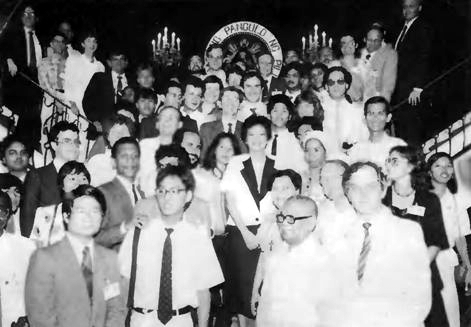
President
Corazon Aquino with some of the RYS participants.
On behalf of the Philippine people, who are presently going through one of their most trying yet promising periods in national history, I am happy to give attention to the work and efforts of the Religious Youth Service.
At this time other nations and international groups have adopted a "wait and see" attitude regarding our fight to revive a battered economy and to solve our pressing problems. You young people from the Religious Youth Service, coming from different religious backgrounds and from more than 30 nations, have won our hearts by coming to our shores to set up a symbol of love in action.
A bridge project, artesian wells, septic tanks, a school building, and even a small forest have been completed. They may someday be used up or replaced, but the beautiful heart of God expressed by you young people from Muslim, Christian, Buddhist, Hindu, Jewish, and other backgrounds will remain and have a lasting place in the hearts of the Philippine people.
I know that without God nothing can be done successfully. When I see God's power move people like you to come together in prayer, action, and loving sacrifice for others, I have hope that there can be peace, prosperity, and happiness for everybody.
May the RYS continue to work in all nations around the world and ignite everywhere the fire of hope and cooperation for a better future.
President Corazon C. Aquino Republic of the Philippines